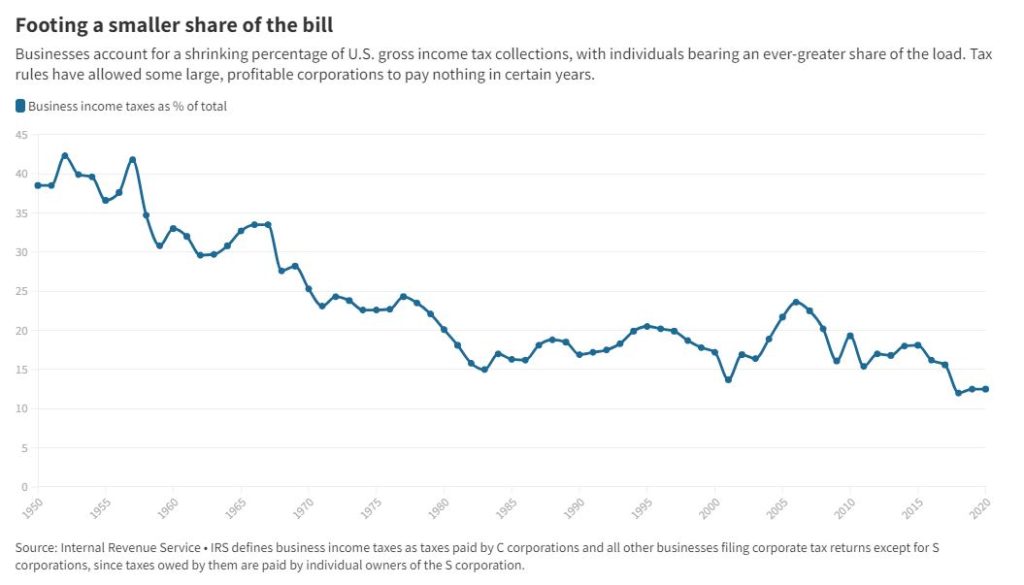1950s: Top Tax Rate: 91%
The Rise of the Single Working Parent Combined Estimated Work Hours: Approximately 40-45 hours per week
During the 1950s, the typical American family often had only one working parent while the other stayed at home to manage household duties and childcare.

With the cost of living relatively lower than in later decades, a single working parent could typically cover basic expenses by working a combined total of 40-45 hours per week.

1960s: Top Tax Rate: 77%
A Continuation of Single Working Parent Households Combined Estimated Work Hours: Approximately 40-45 hours per week
The Revenue Act of 1964 implemented by President Lyndon Johnson. The idea was to cut tax rates to increase job growth. This act cut the top rate to 70%. Furthermore, the standard deduction was initiated and set at $300.

1970s: Top Tax Rate: 70%
The Transition to Dual-Income Households Combined Estimated Work Hours: Approximately 50-55 hours per week
As the 1970s arrived, a gradual shift towards dual-income households became apparent. The rise of women in the workforce, coupled with economic factors, led to an increase in families with both parents working. On average, dual-income households typically combined their efforts, with both parents working around a total of 50-55 hours per week to meet the rising costs of living.

1980s: Top Tax Rate: 28%
Dual-Income Households and a Balanced Approach Combined Estimated Work Hours: Approximately 50-55 hours per week
President Ronald Reagan’s Economic Recovery Tax Act of 1981 greatly reduced the top tax rate from 70% to 50%. The law also indexed tax brackets for inflation. His hope was to encourage savings and investments to stimulate economic growth. Then again in 1986, Ronald Reagan created the Tax Reform Act to further cut taxes and simplify the tax code. The top rate was lowered to 28%, and the standard deduction and personal exemption were increased.

1990s: Top Tax Rate: 31%
Steady Employment with Dual Incomes Combined Estimated Work Hours: Approximately 55-60 hours per week
In the 1990s, the prevalence of dual-income households persisted, but the number of hours each parent worked increased slightly. On average, two working parents put in around a combined total of 55-60 hours per week, as families adjusted to meet rising costs, including child care expenses.

2000s: Top Tax Rate: 35%
The New Millennium and Work-Life Balance Combined Estimated Work Hours: Approximately 60-65 hours per week
President George W. Bush implemented The Economic Growth and Tax Relief Reconciliation Act of 2001 to lower tax rates and drop the top rate to 35%. A new 10% tax was imposed for the first $6,000 of income for individuals ($12,000 for married couples). Bush also initiated The Jobs and Growth Tax Reconciliation Act of 2003. This act cut taxes again and lowered capital gains rates. This greatly benefited high earners.

2010s: Top Tax Rate: 35%
Balancing Work, Family, and Expenses Combined Estimated Work Hours: Approximately 65-70 hours per week
During the 2010s, dual-income households continued to be common. However, the number of hours each parent worked increased slightly, with both typically working around a combined total of 65-70 hours per week to manage expenses, including transportation and child care costs.

2020s: Top Tax Rate: 37%
Toward the Present Day Combined Estimated Work Hours: Approximately 75-80 hours per week
As we approach the present day, it’s apparent that work hours have continued to evolve. In dual-income households of the 2020s, both parents may need to work around a combined total of 75-80 hours per week to cover basic necessities, including the higher costs associated with child care.
President Trump pushed the Tax Cuts and Jobs Act of 2017 through Congress, with numerous changes to the tax law. To highlight a few, the standard deduction nearly doubled, various tax deductions were eliminated, estate tax exclusion nearly doubled, individual tax rates were lowered, and corporate tax rates dropped significantly to a flat 21%.
Lowering the top tax rate in the United States from 91% to 37% has severely hindered the American dream of home ownership. With such a dramatic decrease in tax on the wealthy, income inequality has skyrocketed, making it increasingly difficult for middle and lower-income families to afford homes. The concentration of wealth at the top has created a housing market that is largely inaccessible to those striving to achieve the quintessential American aspiration of owning a home. As the rich get richer and the poor struggle to make ends meet, the dream of home ownership slips further out of reach for many Americans, perpetuating a cycle of economic disparity and thwarting the fundamental principles of equal opportunity and upward mobility.





